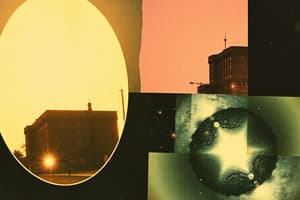Podcast
Questions and Answers
Reflectors are used to focus and direct light in applications like traffic signals and streetlights.
Reflectors are used to focus and direct light in applications like traffic signals and streetlights.
True (A)
Mirrors are typically made of rough, irregular surfaces.
Mirrors are typically made of rough, irregular surfaces.
False (B)
Telescopes use mirrors to gather light and form images.
Telescopes use mirrors to gather light and form images.
True (A)
Different materials absorb, transmit, and reflect light in the same way, causing them to appear the same color.
Different materials absorb, transmit, and reflect light in the same way, causing them to appear the same color.
Reflection is not a fundamental property of light that shapes our everyday lives.
Reflection is not a fundamental property of light that shapes our everyday lives.
Flashcards are hidden until you start studying
Study Notes
Light and Reflection
Light, a wavelike form of energy, is essential for our daily lives and the functioning of our planet. Its ability to reflect, or bounce back off surfaces, is a fundamental property that shapes our visual world and has numerous applications across science and technology.
Reflective Properties of Light
When light strikes a surface, it can be absorbed, transmitted, or reflected. Reflection occurs when the light bounces off the surface, maintaining the same wavelength but changing direction. This property is what allows us to see images in mirrors and understand the way light behaves when it interacts with objects.
The angle at which light strikes a surface, called the incident angle, and the angle at which it reflects, known as the reflected angle, are related by a principle called the Law of Reflection. This law states that the angle of incidence is equal to the angle of reflection.
Types of Reflection
There are two main types of reflection: specular reflection and diffuse reflection.
-
Specular reflection: This type of reflection occurs when the light is reflected at an angle equal to the angle of incidence. In this case, the reflected light appears like a mirror image of the incident light. This type of reflection is found in smooth surfaces such as mirrors or polished metals.
-
Diffuse reflection: This type of reflection occurs when the light is scattered in various directions, producing a more diffused, or spread out, reflection. This type of reflection is found in rough, irregular surfaces such as paper or matte paint finishes.
Reflection and Mirrors
The properties of reflection are used to make mirrors that can reflect light and create images. Mirrors are typically made of smooth, reflective surfaces such as polished metals or glass. By understanding the Law of Reflection, scientists and engineers can design mirrors with specific shapes and sizes to achieve desired effects, such as magnifying objects or creating optical illusions.
Reflection and Lighting
Reflection plays a significant role in lighting because it allows light to be redirected and distributed in various ways. For example, reflectors are used to focus and direct light in applications such as traffic signals, streetlights, and headlights. In the field of interior design, reflective surfaces are used to enhance lighting and create a sense of spaciousness.
Reflection and Optical Instruments
Reflection is a key component in the design and function of optical instruments, particularly those that involve mirrors. Telescopes, for instance, use mirrors to gather light and form images, while cameras use mirrors to divert light to the image sensor.
Reflection and Color
The way light reflects off an object depends on the object's composition and surface properties. Different materials absorb, transmit, and reflect light to varying degrees, causing them to appear different colors. By understanding the reflective properties of light, we can better understand the nature of color and the way our eyes perceive it.
In conclusion, reflection is a fundamental property of light that shapes our everyday lives in numerous ways. Its applications range from the design of mirrors to the functioning of optical instruments, and its properties help us understand the nature of color and light itself. Through research and exploration, we continue to discover new ways to harness reflection's power and unlock its potential for the future.
Studying That Suits You
Use AI to generate personalized quizzes and flashcards to suit your learning preferences.




